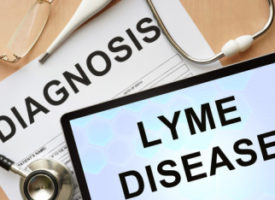Everybody knows about Lyme disease. It’s an infection transmitted by deer ticks in wooded areas of the Northeastern US that causes a red bulls-eye rash and flu-like symptoms and is treated with antibiotics, right?
Yes and no. Lyme disease is caused by a bacterial infection, Borrelia burgdorferi, although many patients are also infected by other tick-borne pathogens that may trigger even more problems. Infected ticks are not limited to the Northeast but are found throughout the US. More than 300,000 Americans are infected every year—10 times more than previously believed.
Diagnosing Lyme Disease Can Be Tricky
Only 50 percent of individuals infected with Lyme disease report the characteristic bulls-eye rash, and a similar number don’t recall a tick bite at all. Instead, they have a wide range of symptoms that are easily mistaken for other conditions. Lyme disease symptoms can run the gamut from transitory fever and achiness to severe, enduring, and debilitating pain and dysfunction affecting systems throughout the body.
That’s why as many as 40 percent of patients with chronic problems end up consulting multiple doctors and suffering for years before getting a proper diagnosis. Misdiagnoses, unfortunately, are all too common. Rather than Lyme disease, patients may be told they have autoimmune disorders, chronic fatigue, fibromyalgia, Parkinson’s, even hypochondria or other psychological problems. As a result, they may be treated with intensive, expensive prescription drugs that have no chance of helping and actually make them worse.
Lyme Disease Wars
The truth is, Lyme disease is in many ways a mystery. Conventional diagnostic lab tests are notoriously unreliable, and huge schisms exist in the medical community about how it should be treated.
In one corner of the “Lyme wars” is the large and influential Infectious Diseases Society of America, which contends that chronic, long-term Lyme disease doesn’t even exist. In the other corner are physicians who are willing to use more sophisticated testing and treat their patients with alternative therapies such as IV nutrients, hyperbaric oxygen, immune-boosting supplements, and/or longer and varying antibiotic regimens.
Unfortunately, insurance companies often refuse to pay for “experimental” tests and therapies, and innovative doctors who use these Lyme disease treatments are sometimes shunned or harassed by their conventional colleagues and medical boards.
Controversial or not, when a patient comes to Whitaker Wellness with a slew of mysterious symptoms or a diagnosis of Lyme disease, we’re going to do our best to get the bottom of it and find a solution.
Lyme Disease Treatments That Really Work
The usual Lyme disease treatment protocol is a two- to four-week course of antibiotics, which is an entirely appropriate use for antibiotics. This approach may be effective, especially if the infection is diagnosed and addressed right away. But chronic Lyme disease requires much, much more.
At Whitaker Wellness, we use cutting-edge lab tests to look for various strains of Borrelia and other infectious agents and follow the latest antibiotic protocols for targeting specific bacteria.
We treat patients with intravenous therapies, such as glutathione, minerals, and vitamins, including vitamin C, which has direct antimicrobial activity. Because Borrelia thrives in a low-oxygen environment, hyperbaric oxygen therapy, which saturates the system with oxygen, is another good treatment.
Medicinal herbs and nutritional supplements that support the body’s ability to fight infection, and LDN, a proven immune enhancer, are also cornerstones of our Lyme disease treatment program.
Finally, we address our patients’ pain and diverse symptoms with the safe, effective therapies Whitaker Wellness is known for: neurofeedback for cognitive problems, EECP for vascular issues, and high-intensity laser, acupuncture, and PRP for pain, to mention a few.
It’s high time physicians and insurance companies pull their heads out of the sand and help, rather than hinder patients by acknowledging chronic Lyme disease for what it is: a very real and difficult condition that cannot be cured overnight.
Debra Has “A New Lease on Life”
After more than two years of misdiagnoses and inappropriate treatment, Whitaker Wellness patient Debra can tell you there is hope for chronic Lyme disease. “Although it is a slow recovery, I am finally headed in the right direction. Every day, I get back a little piece of my former self, and I will be forever grateful for a new lease on life.” (Read Debra’s full story here.)
My Lyme Disease Treatment Protocol
Chronic Lyme disease is a serious and stubborn condition, and there’s no simple solution that works for everyone. However, a personalized regimen of appropriate antibiotics, IV therapies, hyperbaric oxygen, and targeted immune boosters can get patients on the road back to health.
The International Lyme and Associated Diseases Society’s website, ilads.org, is a good source of information and can guide you to experienced physicians. To learn more about Lyme disease treatment at Whitaker Wellness, call 866-944-8253.


